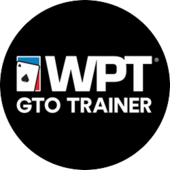3-Bet from the Big Blind with K♠Q♦, what do you do here?
DECISION POINT: In a $2-5 game it folds around to the Cutoff who open raises to $15 and the Button and Small Blind both fold. You reraise to $60 from the Big Blind with K♠Q♦ and the Cutoff calls. The flop comes 4♥T♣J♣ and action is on you, what do you do here?
PRO ANSWER: We are playing in a cash game and are dealt K♠Q♦ in the Big Blind. It folds around to the Cutoff who makes a standard open to 3 big blinds. Action folds to us and we decide to 3-bet our KQo to 4x their raise, or 12BBs. The Cutoff calls and we see a flop.
The flop is 4♥T♣J♣. This is actually a really awkward spot for us. We did flop an open ended straight draw with two over cards, but we also have several things working against us here. This board is quite a bit better for the preflop caller’s range. While we have JJ/TT in our range and maybe some JTs, our opponent has some JJ/TT (that didn’t 4-bet preflop) as well as JTs/44 in their range. Villain will also call with a fair amount of suited hands in their range potentially giving them a lot of flush and backdoor flush draws.
Against tough, aggressive opponents the solvers recommend a mixed strategy of checking around 60% of the time, betting bigger (¾ pot) 15% of the time and betting smaller (¼ pot) around 25% of the time. All of these have roughly equal EV so this is a spot where if we have opponent specific information we can take exploitative lines.
Continued below...
For example, if our opponent plays very fit or fold postflop we would want to continuation bet more here. However, if they are the type of player that will stab every time it is checked to them on a coordinated board in-position, checking here with the intention of raising is the better play.
This is one of those really interesting spots where technically any choice we decide on could be “correct” but if we have opponent specific information we can improve our win rate dramatically by taking an exploitative line.
Game Theory Optimal does like checking more frequently than betting in this spot as a way to protect our overall checking range so we’re not check/folding too often, but all options are roughly the same EV so anything specific on our opponent can quickly tip the scales.
With no opponent information, checking is the best play.
How would you play it?
Share your answer in the comments below!
TEST YOUR SKILLS!
PLAY 5 HANDS FROM THIS SCENARIO
In a Cash Game with 100 big blind stacks, the Cutoff open raises to 3BBs. You reraise to 12BBs from the Big Blind and the Cutoff calls.
Play through 5 FREE hands similar to this poker hand scenario by clicking below and see how close you are to GTO play:
Hint: your goal is to get as close to 0 EV loss as possible!
LearnWPT Members train using Cash Game scenarios like these on the WPT GTO Trainer to adjust their decisions and get closer and closer to GTO strategy.
Not a Member? Join now and start training for just $5 your first month of Membership. Play and practice scenarios like this anytime (and as often as you like) and start seeing true stats for YOUR play!



